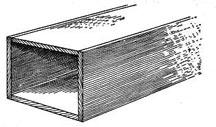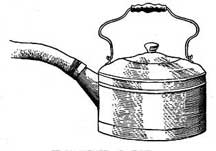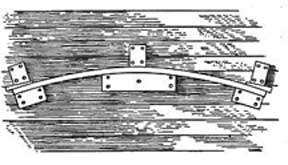How To Bend Wood
|
This information has been reprinted from a 1912 Popular Mechanics publication titled "Mission Furniture And How To Make It". The process for making bent wood for furniture parts is the same as for any other kind of bent-wood work. The pieces should be made close to the size, with only enough material left on them for "cleaning up" after the bending has been done. The pieces used for the bent work should be good, clean, "live" lumber. Lumber dried on the stump will not bend.
A box must be made in which to steam the pieces of wood to be bent. A design of a steaming box is shown in the illustration. Such a box is made by nailing four boards together into a square or rectangular form, the boards having a length sufficient to take in the length of the furniture parts to be bent. Both ends of the finished box are squared up and closed with a board cut to the size, using felt or gunny sack in the joint to make it as tight as possible. These ends can be nailed on, but it is best to hold them with a bar of metal set against each one. Nailing the ends a few times would spoil the box for further use in steaming.
A good teakettle will serve the purpose for a steam generator. A hose is attached to the spout of the teakettle, as shown in the illustration, and to the steaming box in a like manner. The steaming box should be provided with a short piece of gas pipe turned into a hole bored into one of the sides used for the top on which to attach the hose. A small hole should be bored into one side of one end of the steaming box, and this end should be arranged a trifle lower than the other end. The hole will permit the water of condensation to escape. Steam should not escape from the box when a charge of wood is being softened. Steam which escapes from the box in the form of vapor has done no work whatever, and is just so much waste of fuel. In order to give up its heat to the wood, the steam must condense and come away from the box as water. Therefore, in steaming a charge of pieces in the box, never crowd the teakettle so hard that the steam escapes around the heads of the box or through any other joints. The steam should be supplied to the box just as fast as it condenses, and no faster. When the pieces are placed in the box they should be so arranged that the steam can find ready access to all sides of each piece.
The curve or bend of the piece to be made must be marked out on a wide board or on the floor. Nail down several blocks of wood or pieces cut out like brackets on the board or floor against the drawing, as shown in the illustration. The wood is sprung between these blocks or forms after it has been softened by steam. When taking the steamed pieces from the box do not lose any time in securing them to the forms. Do not take out more than one piece at a time, as it must be bent to the forms immediately after taking it from the hot steam. The time of the steaming will vary with the size of the pieces. Small strips may be steamed in 15 or 20 minutes, while large ones may require several hours to become soft enough to bend. The pieces must be left in the forms until they are thoroughly dry. |






